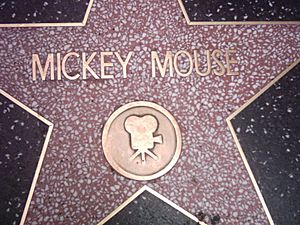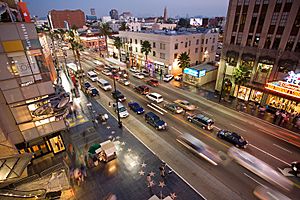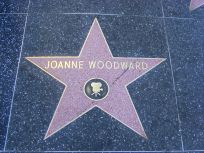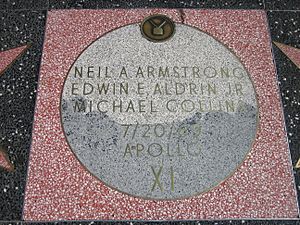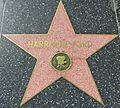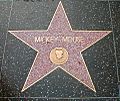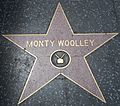Hollywood Walk of Fame facts for kids
The Hollywood Walk of Fame is a famous sidewalk in Hollywood, Los Angeles, California, USA. It's like an outdoor museum celebrating people who have done amazing things in entertainment. More than 2,600 stars are set into the ground along 15 blocks of Hollywood Boulevard and three blocks of Vine Street. These stars honor actors, musicians, directors, and even fictional characters!
The Hollywood Walk of Fame is managed by the Hollywood Chamber of Commerce. It's a very popular place for tourists, with millions of visitors each year.
Contents
What is the Hollywood Walk of Fame?
The Walk of Fame stretches for about 1.3 miles (2.1 km) on Hollywood Boulevard. It also goes for about 0.4 miles (0.6 km) on Vine Street. This famous sidewalk attracts around 10 million visitors every year. It's a huge part of why tourism is so important in Los Angeles County.
What Do the Stars Look Like?
As of 2017, there are over 2,600 stars on the Walk of Fame. Each star is made of coral-pink terrazzo and has a brass rim. The name of the honored person is written in brass letters. Below the name, a round brass emblem shows what type of entertainment they are famous for.
There are five main categories:
 Movie Camera for motion pictures (films)
Movie Camera for motion pictures (films) Television Set for broadcast television
Television Set for broadcast television Phonograph Record for audio recording or music
Phonograph Record for audio recording or music Radio Microphone for broadcast radio
Radio Microphone for broadcast radio Comedy/Tragedy Masks for theatre or live performances (added in 1984)
Comedy/Tragedy Masks for theatre or live performances (added in 1984)
Almost half of all stars are for movies (47%). About 24% are for television, 17% for music, and 10% for radio. Only a small number (less than 2%) are for live performances. Around 20 new stars are added every year.
Are There Any Special Stars?
Yes, some stars are unique! For example, former Los Angeles mayor Tom Bradley's star shows the Seal of the City of Los Angeles.
The monuments for the Apollo 11 mission to the Moon are also very special. They are shaped like four circular moons. These moons honor the three astronauts (Neil A. Armstrong, Edwin E. Aldrin Jr., Michael Collins). They also show the date of the first Moon landing ("7/20/69") and the words "Apollo XI". You can find these unique moons at the intersection of Hollywood and Vine.
How Did the Walk of Fame Start?
The idea for the Walk of Fame came from E.M. Stuart in 1953. He was a volunteer president for the Hollywood Chamber of Commerce. Stuart wanted to keep Hollywood famous for its glamour and excitement. A committee was formed to plan the Walk, and architects helped design it. By 1955, the basic idea was ready.
Some say the idea for the stars came from the old Hollywood Hotel. It had stars on its dining room ceiling above tables where famous people sat. Another story says the stars were inspired by a restaurant's drink menu. That menu featured celebrity photos framed in gold stars.
In 1956, a test star was made. It had a drawing of a person inside a blue star. But these drawings were too expensive to make in brass. Also, the blue and brown colors were changed because they didn't match a new building nearby.
How Were the First Stars Chosen?
By March 1956, the final design was approved. It featured the coral-pink and charcoal colors we see today. Between 1956 and 1957, 1,558 people were chosen for stars. Committees picked them from the movie, television, music, and radio industries. Famous people like Walt Disney and Cecil B. DeMille were on these committees.
At first, music artists needed to sell a lot of records to get a star. This rule meant many important musicians wouldn't get one. So, the National Academy of Recording Arts and Sciences was created. This led to the first Grammy Awards in 1959, which honored music artists.
Construction of the Walk began in 1958. However, two lawsuits caused delays. One lawsuit was about the cost of the Walk. The other was about Charles Chaplin Jr.'s father not getting a star. Both lawsuits were settled, and construction continued.
Many people think Joanne Woodward was the very first person to get a star. This is probably because she was the first to be photographed with hers. But the first stars were installed all at once. Woodward's name was one of eight chosen for test stars in August 1958. These test stars were put up to show what the Walk would look like. The first permanent star was for director Stanley Kramer. It was finished on March 28, 1960.
How Did the Walk of Fame Grow?
After the first 1,500 stars were installed in 1960 and 1961, no new stars were added for eight years. In 1962, the Hollywood Chamber of Commerce was put in charge of adding new names. They created rules and ways to pay for new stars.
In 1968, Richard D. Zanuck received the first new star in eight years. In 1978, the City of Los Angeles made the Walk of Fame a historic monument.
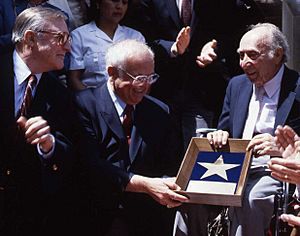
A radio and TV personality named Johnny Grant helped make the Walk popular again. Starting in 1968, he made sure that every person chosen for a star had to attend their unveiling ceremony. This created a lot of excitement and news coverage. In 1980, he started a fee of $2,500 for each star. This fee helps pay for the Walk's upkeep. By 2020, the fee was $50,000.
Johnny Grant received his own star in 1980 for his TV work. In 2002, he got a second special star for his important role in making the Walk famous.
Expanding the Walk
In 1984, a fifth category, Live Theatre, was added. This honored people in live performances. A second row of stars was also created on each sidewalk.
In 1994, the Walk of Fame was made longer. It now ends at the "Four Ladies of Hollywood" gazebo. At this time, Sophia Loren received the 2,000th star on the Walk.
When the subway system was being built in 1996, over 300 stars had to be moved. There was a debate about how to move them. But it was decided that the stars should be removed carefully and kept whole.
Fixing the Stars
In 2008, a big project began to fix the stars. All 2,365 stars were checked for damage. Some stars had holes and cracks, making them unsafe. Plans were made to fix or replace at least 778 stars. This project costs over $4 million.
The repair work is a team effort involving the Hollywood Chamber of Commerce and city offices. The subway line running underneath the Walk might be partly causing some of the damage.
How Do People Get a Star?
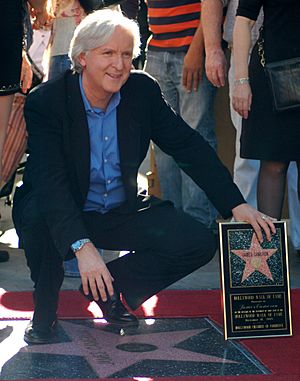
Each year, about 200 nominations are sent to the Hollywood Chamber of Commerce. Anyone can nominate someone, even fans! The person nominated or their manager must agree to it. Nominees need at least five years of experience in their field. They also need to have a history of helping charities.
If someone has passed away, they can be nominated after at least five years. Each June, a committee chooses about 20 to 24 celebrities for stars. One award is given each year to someone who has passed away. If a nominee isn't chosen, their nomination can be considered again the next year.
Living people who are chosen must agree to attend their star's unveiling ceremony within two years. If they don't, a new application must be submitted. A family member must attend for those who have passed away. The ceremonies are open to everyone!
The fee for a star is $50,000 (as of 2020). This money pays for making and installing the star, and for keeping the Walk of Fame clean. Usually, a fan club, movie studio, or record company pays the fee.
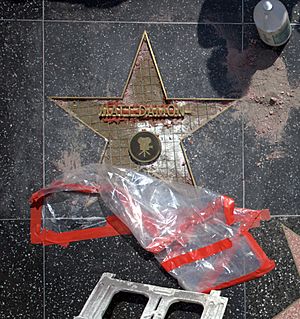
The names of the selection committee members are usually kept secret. This helps prevent people from trying to influence their choices. However, in 1999, the Chamber did share the names of the members.
Special Rules for Stars
The rules for the Walk of Fame usually say that contributions must be in the five main entertainment categories. But sometimes, the committee stretches the rules a bit. For example, the four round Moon landing monuments at Hollywood and Vine honor the Apollo 11 astronauts. They are officially recognized for their "contributions to the television industry."
Magic Johnson got a star in the motion picture category. This was because he owned a chain of movie theaters.
Muhammad Ali's star was given after the committee decided that boxing could be seen as a "live performance." His star is unique because it's on a wall of the Dolby Theatre. This was Ali's request, as he didn't want his name to be walked upon.
Since 1968, all living honorees must attend their star's unveiling. About 40 people have said no because of this rule. The only person who agreed but didn't show up was Barbra Streisand in 1976. Her star was still unveiled. She did attend when her husband, James Brolin, unveiled his star in 1998.
Images for kids
-
Harrison Ford's star, presented to the actor in 2003.
See also
 In Spanish: Paseo de la fama de Hollywood para niños
In Spanish: Paseo de la fama de Hollywood para niños


